Cisco Audio Video Bridging Solution for Converged AV over IP (AVoIP)
Available Languages
Bias-Free Language
The documentation set for this product strives to use bias-free language. For the purposes of this documentation set, bias-free is defined as language that does not imply discrimination based on age, disability, gender, racial identity, ethnic identity, sexual orientation, socioeconomic status, and intersectionality. Exceptions may be present in the documentation due to language that is hardcoded in the user interfaces of the product software, language used based on RFP documentation, or language that is used by a referenced third-party product. Learn more about how Cisco is using Inclusive Language.
This white paper explains the technical details and use cases for the Cisco® Audio Video Bridging (AVB) solution that is available on the Cisco Catalyst™ 9000 switching platforms. It also explains how customers can use this solution to build seamless, professional Audio Video (AV) solutions over existing IP networks.
An analog AV infrastructure has components such as the AV source, AV transmitter, AV receiver, and AV switcher, along with dedicated cabling based on every requirement. The AV switcher can provide only point-to-point connectivity such as 4x4, 8x8, etc. to cover all input and output devices as part of the end-to-end AV network. The analog AV network also faces challenges with high latency caused by complex cabling and the difficulty of interoperating with a wide range of vendors. These challenges also lead to an AV network that is complex to maintain and that requires more time to troubleshoot any issues reported.
Scaling the analog AV network is also very difficult due to the point-to-point nature of the AV switcher. This forces the AV network to be isolated from the network infrastructure across all customer segments, and dedicated cabling, along with complex configurations, is used to deliver a high-quality AV experience, making the analog AV network costly, rigid, and complex to maintain.

A professional analog AV deployment
Migration to an Ethernet infrastructure was seen as a means of addressing the needs of professional AV equipment, in addition to lowering the Total Cost of Ownership (TCO) and enabling transparent integration of new services. However, the deployment mechanism lacked flexibility and interoperability.
To accelerate the adoption of Ethernet-based AV and provide a deployment that is more flexible, IEEE developed the IEEE 802.1 Audio Video Bridging (AVB) standard. This standard defines a mechanism that ensures all the devices, including audio, video endpoints, and network switches, are part of the same AVB domain to provide a flexible, reliable, and high-quality AV solution to enhance the end-user experience.
Many switch and endpoint vendors provide support for IEEE 802.1 AVB. Starting with Cisco IOS® XE Software Release 16.8, Cisco supports the IEEE 802.1BA AVB standard on Catalyst 9000 switches listed in Table1.
Table 1. Catalyst 9000 switches that support AVB
|
|
Catalyst 9300 Series |
Catalyst 9500 Series |
| Supported SKUs |
All 9300 Series SKUs (9300, 9300L, 9300X) |
C9500-24Q C9500-12Q C9500-40X C9500-16X |
Note: C9500 High performance series PIDs such as C9500-32QC, C9500-32C, C9500-24Y4C and C9500-48Y4C also supports AVB from IOS XE 17.9.1 release and are yet to be certified by AVNU.
A Network Advantage license is required to enable AVB on these Catalyst 9000 switching platforms.
AVB is the common name for the set of technical standards developed by the IEEE Audio Video Bridging Task Group of the IEEE 802.1 standards committee. This task group was later renamed the Time-Sensitive Networking [TSN] Task Group in November 2012 to reflect the expanded scope of its work. IEEE 802.1 defines a set of standards that provide the means for highly reliable delivery of low-latency, time-synchronized AV streaming services through Layer 2 Ethernet networks.
The set of IEEE 802.1 standards consists of the following:
● IEEE 802.1AS: Generalized Precision Time Protocol (gPTP), which provides timing and synchronization for time-sensitive applications on Layer 2 devices.
● IEEE 802.1Qat: Stream Reservation Protocol (SRP) and Multiple Stream Reservation Protocol (MSRP), which is an end-to-end traffic admission control system that helps ensure the availability of resources, such as bandwidth and latency, that are required to transport AV streams.
● IEEE 802.1Qav: Forwarding and Queuing for Time-Sensitive Streams (FQTSS), which provides AV traffic scheduling capability for mainstream Ethernet and other network switches.
● IEEE 802.1BA: An umbrella standard for the other three IEEE 802.1 standards that defines profiles for features, options, configurations, defaults, protocols, and procedures for AVB devices.
Benefits of Audio Video Bridging
Customers who are looking to overcome the complexity of an analog AV network can now deploy AV over IP through their existing Layer 2 Ethernet infrastructure. This requires not only the network infrastructure but also the AV endpoints to be in sync with each other to deliver a high-quality and low-latency AV experience.
With the help of Cisco AVB solution on Catalyst 9000 switches, customers can now achieve:
● A low-cost AV solution that is easy to deploy and maintain
● Improved efficiency with <2-ms accuracy up to seven physical hops
● Flexibility to scale AV bandwidth requirements from a few Mbps to 1G, 10G, 40G, or 100G in no time by making use of their existing Layer 2 Ethernet infrastructure
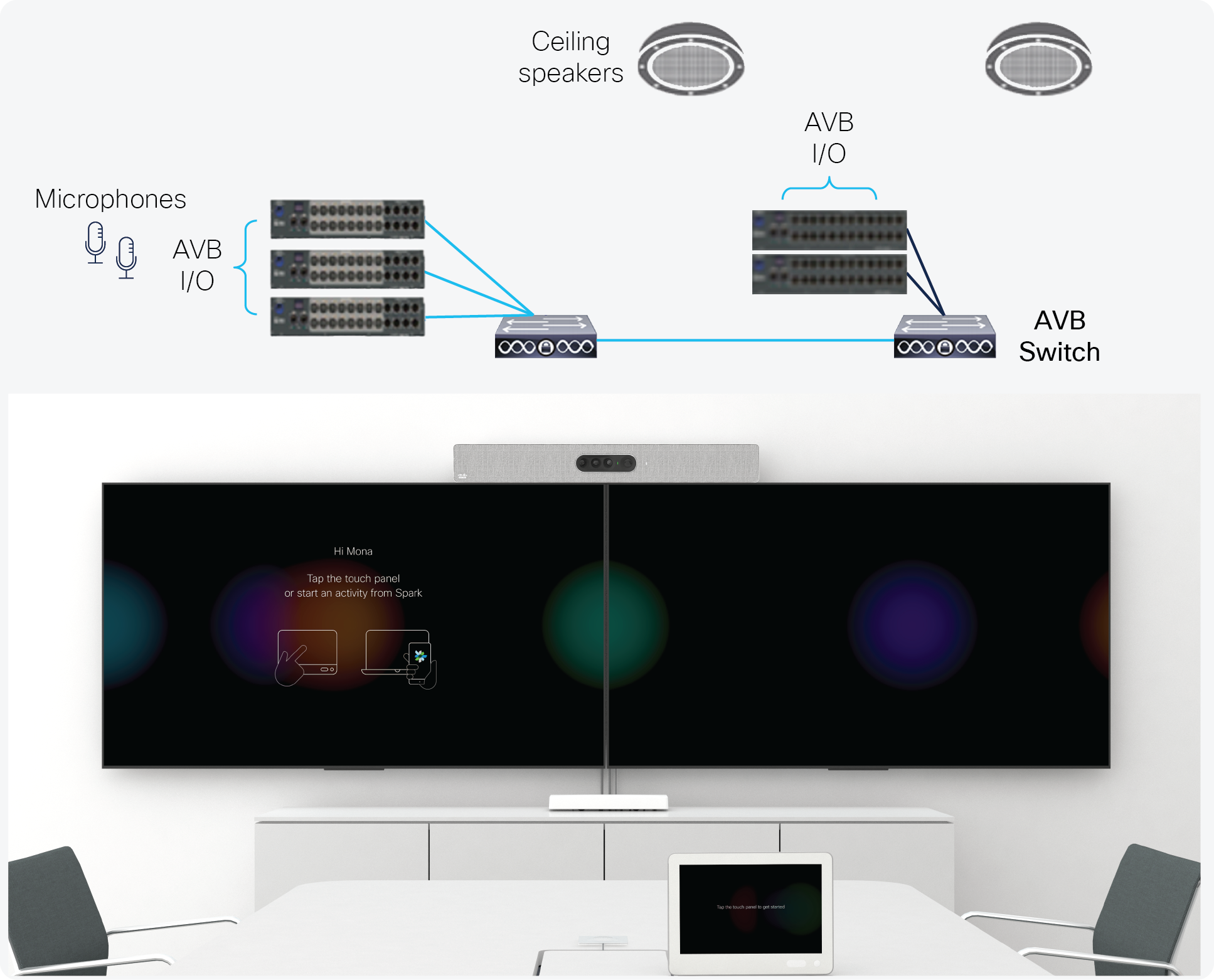
An AVB deployment in a next-generation collaboration room with AV endpoints connecting to an AVB switch
AVB protocols operate only in domains in which every device is AVB capable. The AVB network consists of AVB talkers, AVB listeners, and AVB switches.
The AVB talker is an AVB end station that is the source or producer of a stream. An example of this would be an AVB-capable microphone.
The AVB listener is an AVB end station that is the destination or consumer of a stream, such as an AVB-capable speaker.
In many cases, the AV endpoints (microphones or speakers) are analog devices. AVB endpoint vendors introduce Digital Signal Processors (DSPs) and I/O devices that perform extensive AV processing and aggregate the endpoints, as shown in Figure 3. Tesira from Biamp and D-Mitri from Meyer Sound are examples of such a digital audio platform. These digital audio platforms are AVB talkers or listeners on behalf of those analog devices.

The AVB switch, or bridge, is an Ethernet switch that complies with the IEEE 802.1 AVB standards.
The AVB stream is a data stream associated with a stream reservation that complies with SRP.
The IEEE 802.1BA specification requires an AVB talker to be grandmaster capable. In a typical deployment, a network node can also be the grandmaster, provided that it can either source or derive timing from a grandmaster-capable device. An IEEE 802.1AS network timing domain is formed when all devices meet the requirements of the IEEE 802.1AS standard and communicate with each other using the IEEE 802.1AS protocol. The clock of one device is chosen as the reference clock for synchronization purposes. This device is referred to as the grandmaster.
The device also must provide the timing to the AVB network using IEEE 802.1AS. Figure 4 shows a simple AVB network with its components.
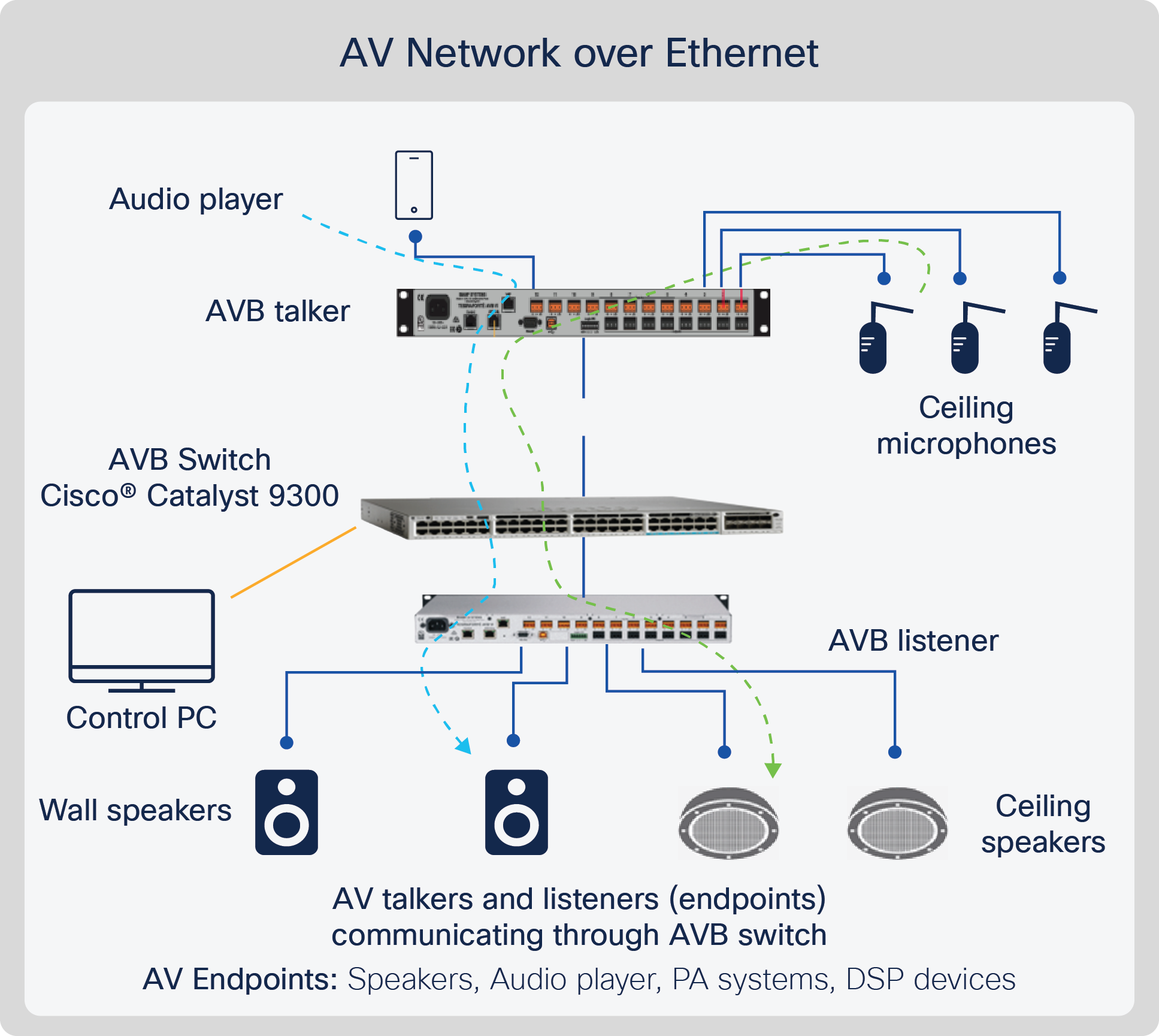
AVB solution technical details
Time synchronization (IEEE 802.1AS)
IEEE 802.1AS gPTP is based on the IEEE 1588 Precision Time Protocol (PTP). It defines best algorithms for selecting the primary clock, link delay, and network queuing measurement and compensation, and clock-rate matching and adjustment mechanisms for Layer 2 network devices.
Each grandmaster-capable device broadcasts its clock parameters through announce messages. The best algorithm for selecting the primary clock is used to select the primary and secondary states of the port on each link, using the announce messages. The best clock selected as the primary depends on the quality of the clock and configurations such as gPTP priority. Figure 3 shows an example of an AVB network with the grandmaster and AVB switch gPTP port status. The primary port is the source of the time on the path. The secondary port synchronizes its time with the primary port.
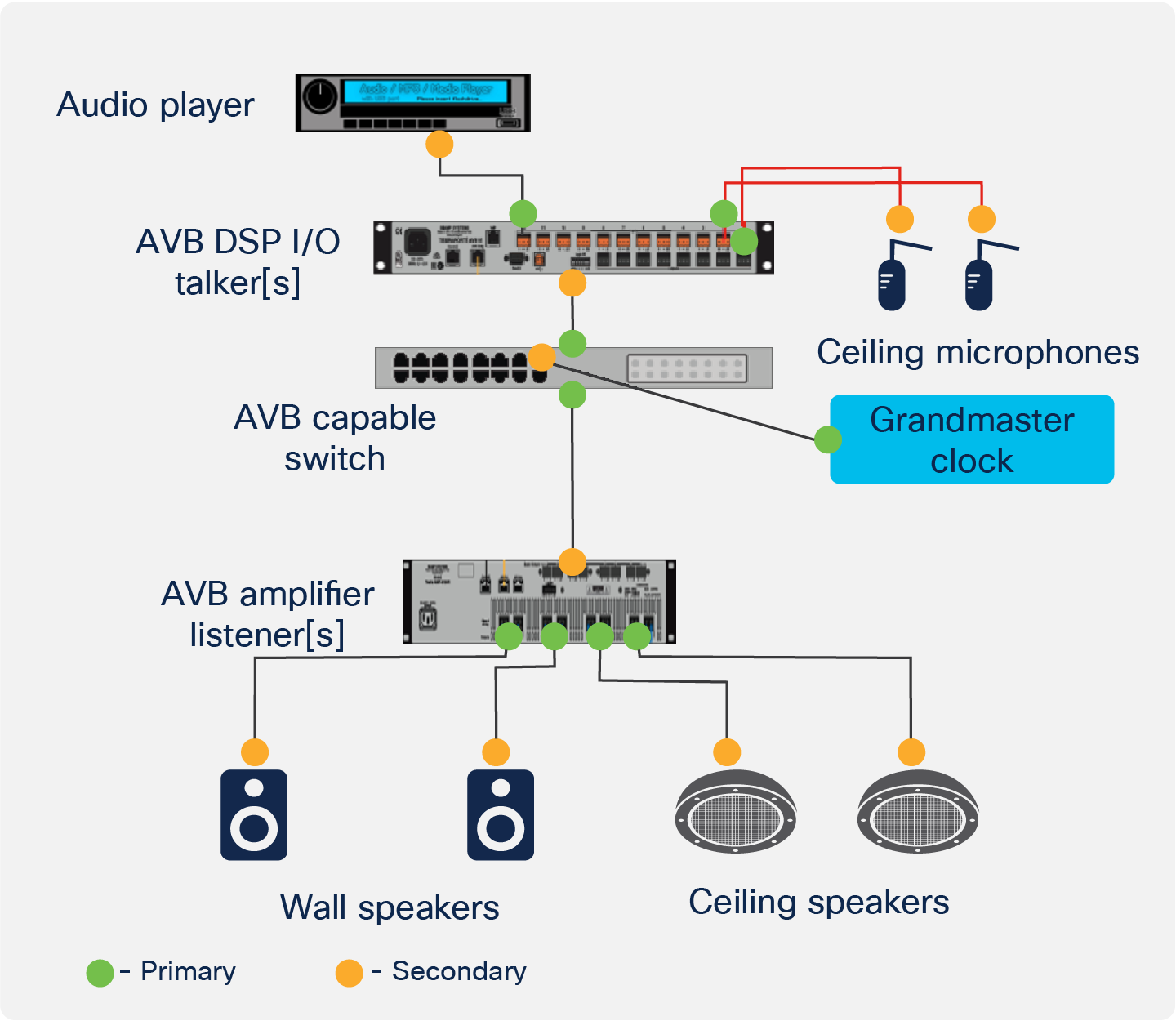
AVB network time synchronization
To use IEEE 802.1AS, streams must include a presentation time. All devices in the network can then align their playback by comparing the presentation time information in the stream packets with the IEEE 802.1 AS common time base. One advantage of this approach is that with IEEE 802.1AS and presentation time encapsulated streams, an AVB network inherently supports multiple simultaneous sample rates and sample clock sources. This support allows, for example, video and audio streams to be synchronized even though they travel on different paths with different sample rates. A second advantage of using presentation time is that if two devices are outputting the same stream, they are precisely locked in their playback, even if they are on different networks at different distances from the source.
IEEE 802.1Qat MSRP provides mechanisms for reserving stream bandwidth that allow endpoint applications to configure the routes automatically, eliminating the need to manually configure Quality of Service (QoS) across network devices. MSRP checks end-to-end bandwidth availability before an AV stream starts. The bandwidth allocated for AV streams is limited to a maximum 75 percent of the total port bandwidth. If bandwidth is available, it is locked down along the entire path until it is explicitly released.
MSRP signaling is based on a set of talker and listener declarations. MSRP-aware switches register and deregister talker and listener declarations on the switch ports to set up the AVB sessions and automatically generate deregistration of stale registrations to tear down the AVB sessions.
A talker declaration is forwarded over output ports that can potentially lead to the destination MAC address of the reservation. The talker declarations are “advertise” and “failed” which are propagated by MSRP so that the listeners and switches are aware of the presence of talkers and their streams (Figure 6).
An advertise declaration is an advertisement for a stream that has not encountered any bandwidth or other network constraints along the network path from the talker. The listeners that register with this stream are likely to create a reservation with the described QoS. A talker advertises messages contain the following information necessary to make a reservation:
● Stream ID (48-bit MAC address associated with the talker plus a 16-bit ID)
● Stream destination address (a multicast group MAC address)
● VLAN ID
● Priority (used to determine the traffic class)
● Rank (emergency or nonemergency)
● Traffic specification (maximum frame size and maximum number of frames per class)
● Measurement interval (accumulated latency)
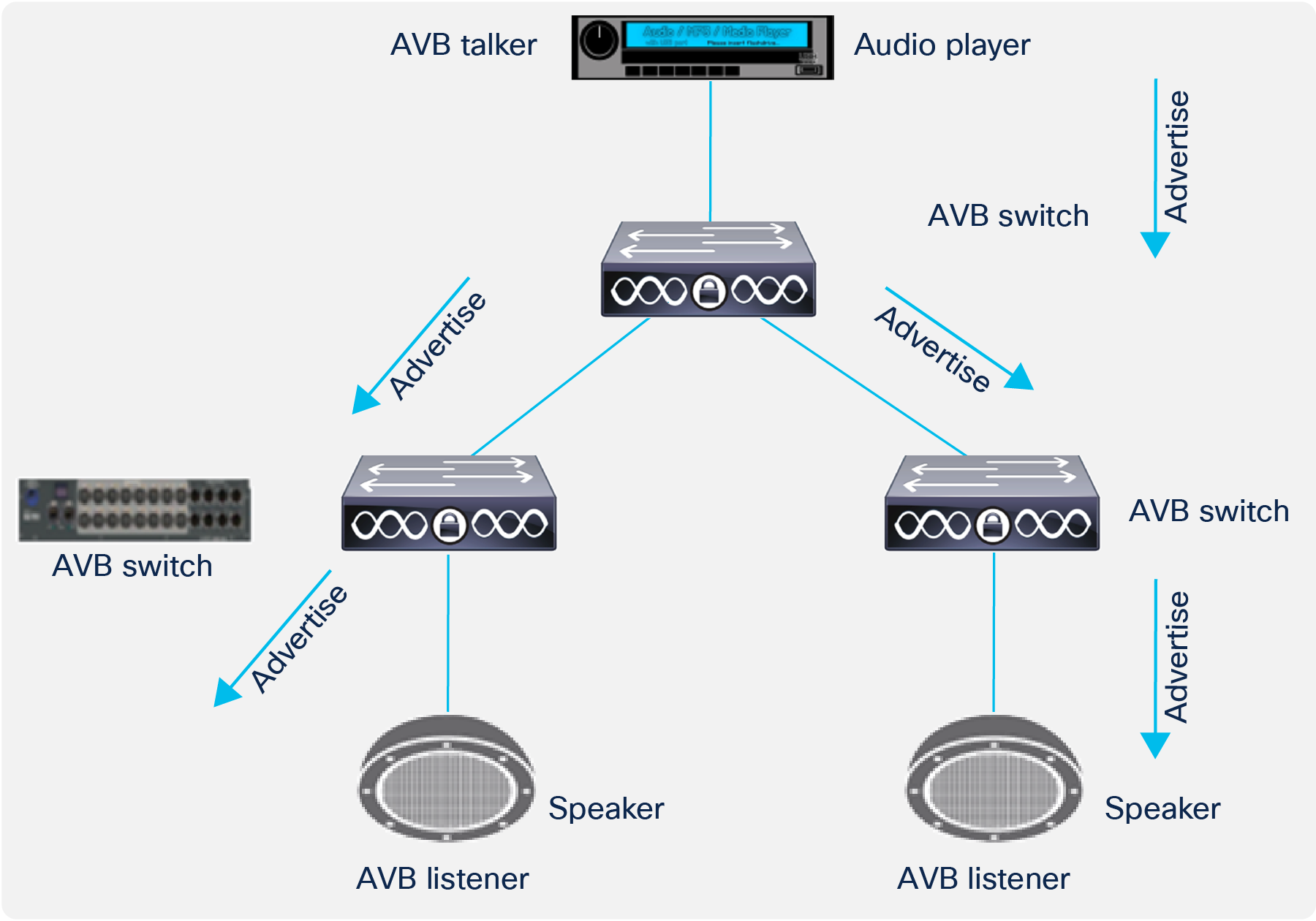
AVB talker declaration message propagation
A failed declaration is an advertisement for a stream that is not available to the listener because of bandwidth constraints or other limitations somewhere along the path from the talker.
The listener declarations are “ready,” “ready failed,” and “asking failed.” These declarations convey the results of the bandwidth allocation along its path back to the talker.
● A ready declaration means that one or more listeners are requesting attachment to the stream. Sufficient bandwidth and resources are available along the paths to the talker for all listeners to receive the stream.
● A ready failed declaration means that two or more listeners are requesting attachment to the stream. At least one of those listeners has sufficient bandwidth and resources along the path to receive the stream. One or more other listeners cannot receive the stream because of network bandwidth or resource allocation problems.
● An asking failed declaration means that one or more listeners are requesting attachment to the stream. None of the listeners can receive the stream because of network bandwidth or resource allocation problems.
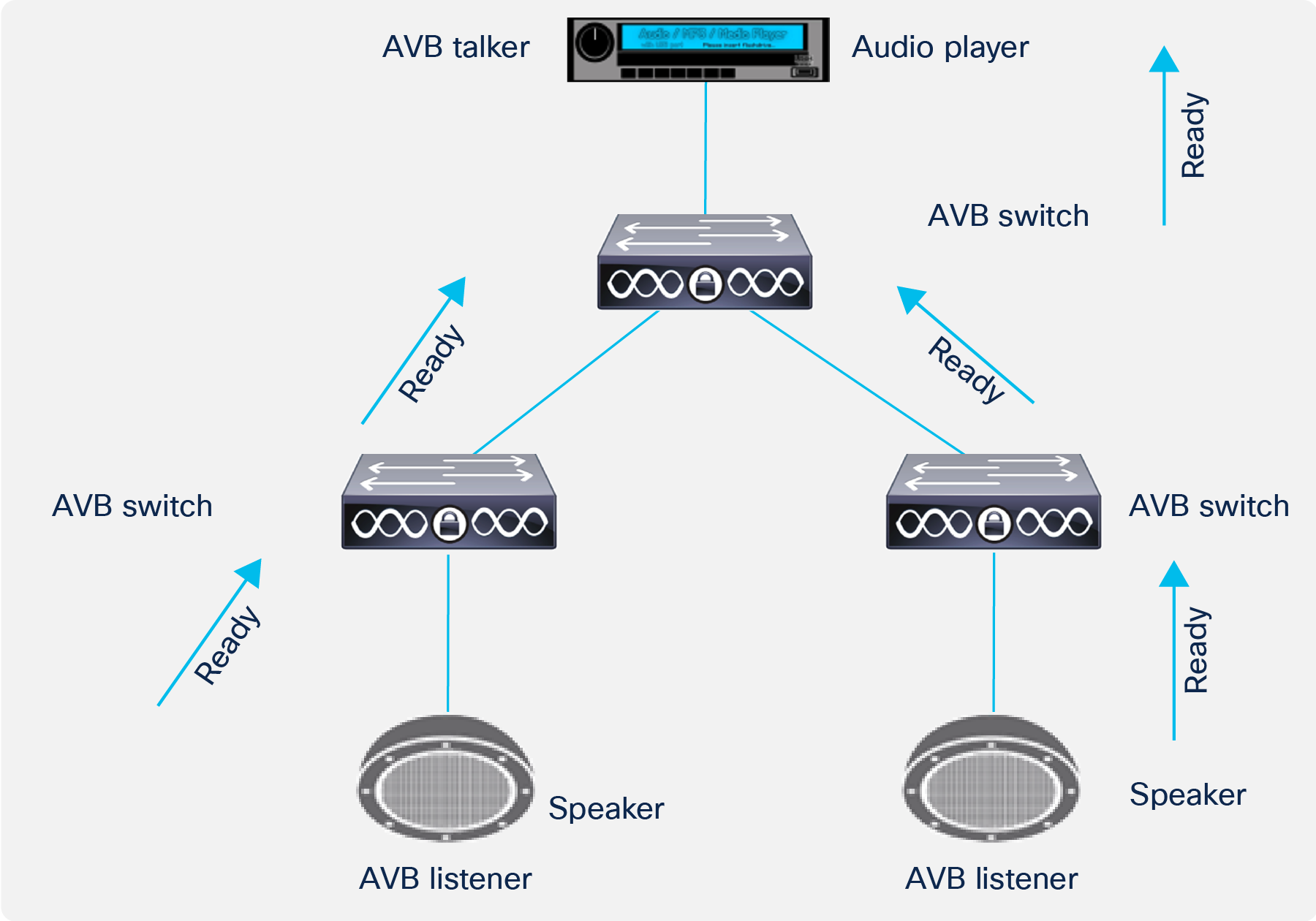
AVB listener declaration message propagation
End-to-end stream reservation is successful only when an AVB listener receives an AVB talker advertise message and the AVB talker receives an AVB listener ready message. During stream reservation, MSRP interfaces with gPTP to set up the correct timing profile. MSRP requires two pieces of information from gPTP:
● Per-port status indicating whether the port is gPTP capable: This information is used to determine the SRP domain boundary.
● Per-port peer delay: Peer delay and residence delay on AVB switches are used to accumulate delays along each hop of a reservation to help ensure that latency requirements are met. A stream session is set up only when end-to-end latency meets the requirements.
During the creation of a stream session, MSRP also interfaces with QoS to trigger allocation of hardware resources:
● Add end-to-end per-interface AVB switch QoS configurations, including bandwidth allocation for AVB streams and traffic shaper configuration based on IEEE 802.1Qav.
● Add the Layer 2 multicast route to distribute AVB streams from talkers to listeners.
AVB streams are forwarded only upon successful creation of an AVB stream session. After AVB streams stop, MSRP automatically releases reserved resources on AVB switches and tears down the AVB session.
Forwarding and Queuing for Time-Sensitive Streams (IEEE 802.1Qav)
IEEE 802.1Qav defines forwarding and queuing rules for AVB traffic: the type of AVB stream classes, corresponding QoS properties, how to schedule delivery of time-sensitive AV streaming data, and so on. IEEE 802.1Qav works together with MSRP. MSRP manages the bandwidth and admission control. It interfaces with IEEE 802.1Qav to determine and allocate the required bandwidth for the stream. IEEE 802.1Qav schedules time-sensitive AV streaming data, helping ensure timeliness through the network. Regular non-AVB traffic is treated in such a way that it cannot interfere with reserved AVB traffic. Using the AVB protocols, intelligent devices communicate with the network to provide reliable AV streaming without the need for the installer to perform extensive manual tuning of the network.
An AVB network has different classes of traffic. Here are some examples:
● Stream Reservation (SR) class A: This class has the highest priority in the AVB network. The worst-case latency requirement in a network is 2 ms for SR class A traffic. MSRP uses the per-port peer-delay information provided by gPTP and AVB switch residence delay to calculate the accumulated delays along each hop of a stream reservation to help ensure that the latency requirements are met.
● SR class B: This class has the second highest priority in the AVB network. The worst-case latency requirement in a network is 50 ms for SR class B traffic.
● Control traffic: This class has the third highest priority in the AVB network. It includes gPTP and MSRP traffic.
● Best-effort traffic: This class has the lowest priority in the AVB network. It consists of non-AVB traffic.
On ingress, traffic is classified into different ingress queues based on the Class-of-Service (CoS) field. Sometimes non-AVB ingress traffic to a non-AVB port carries a CoS value that is the same as the SR class CoS value. To prevent non-AVB traffic from being misclassified as AVB traffic, ingress QoS remarking is performed on all non-AVB ports to help ensure that non-AVB traffic traverses the AVB network as best-effort traffic.
On egress, frame forwarding behavior is based on the priority. The SR class traffic is mapped to the egress queue that supports the credit-based traffic shaper algorithm. The credit-based traffic shaper algorithm is used to shape the transmission of the SR class streams. Traffic shaping is the process of smoothing out the traffic for a stream, distributing the stream’s packets evenly in time. If traffic shaping is not performed at sources and switches, the packets tend to bunch, or agglomerate, into bursts of traffic, which can overwhelm the buffers in subsequent switches. Traffic shaping helps reduce or eliminate network congestion for AVB traffic.
The QoS configuration on AVB switch ports is initiated by MSRP when bandwidth is reserved. This configuration is removed automatically when the bandwidth is released by MSRP.
This section talks briefly about how customers across different segments can deliver low-latency and high-quality AVoIP using the Cisco AVB solution.

Use cases for the Cisco AVB solution
Next-generation collaboration, as shown in Figures 8 and 2, converges the AVB-capable endpoints such as microphones and speakers to the existing IP infrastructure.
Conference rooms and townhalls, where business announcements are carried out, can deliver a high-quality and low-latency AV experience for the audience with the help of Cisco AVB.
Digital courtrooms and government newsrooms require precision timestamping across the network infrastructure and AV endpoints for digital record keeping.
Media and entertainment customers or content creators require high-quality AV streams at variable bandwidths that can be used by different teams to enhance the content production.
Analog AV networks are costly to deploy and maintain and are plagued by latency issues along with a lack of interoperability and standard configuration. These challenges paved the way for the open standards-based IEEE 802.1BA AVB solution, which can provide <2-ms accuracy and allow AV infrastructure to converge with an existing Layer 2 Ethernet infrastructure.
The Cisco AVB solution with Catalyst 9000 switches, implemented through proven Cisco IOS XE Software, can provide a best-in-class feature set that will allow customers to converge their AV infrastructure to their existing IT infrastructure with ease. This will also help customers reduce dedicated cabling infrastructure for their AV network and lower their TCO by 60% on CapEx and 35% on OpEx over five years.1
With AVNU certified Cisco Catalyst 9000 switches and AV endpoints, customers can now design an AVB network that is:
● Simple to deploy and maintain
● Reliable, with a high level of accuracy
● Flexible to scale
● Cost-effective